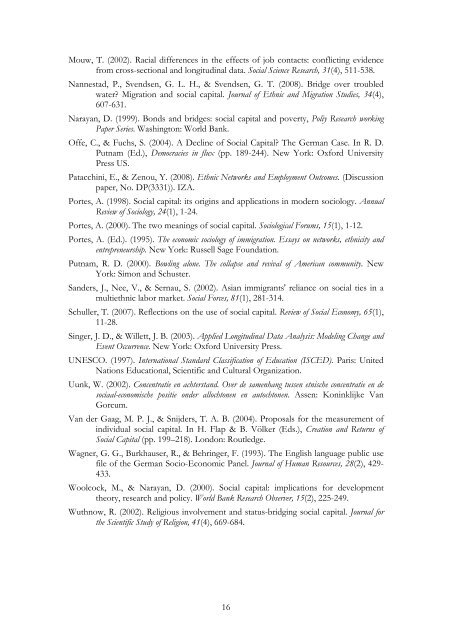Turkish migrants and native Germans compared - IMISCOE Cross ...
Turkish migrants and native Germans compared - IMISCOE Cross ...
Turkish migrants and native Germans compared - IMISCOE Cross ...
Create successful ePaper yourself
Turn your PDF publications into a flip-book with our unique Google optimized e-Paper software.
Mouw, T. (2002). Racial differences in the effects of job contacts: conflicting evidencefrom cross-sectional <strong>and</strong> longitudinal data. Social Science Research, 31(4), 511-538.Nannestad, P., Svendsen, G. L. H., & Svendsen, G. T. (2008). Bridge over troubledwater? Migration <strong>and</strong> social capital. Journal of Ethnic <strong>and</strong> Migration Studies, 34(4),607-631.Narayan, D. (1999). Bonds <strong>and</strong> bridges: social capital <strong>and</strong> poverty, Poliy Research workingPaper Series. Washington: World Bank.Offe, C., & Fuchs, S. (2004). A Decline of Social Capital? The German Case. In R. D.Putnam (Ed.), Democracies in flux (pp. 189-244). New York: Oxford UniversityPress US.Patacchini, E., & Zenou, Y. (2008). Ethnic Networks <strong>and</strong> Employment Outcomes. (Discussionpaper, No. DP(3331)). IZA.Portes, A. (1998). Social capital: its origins <strong>and</strong> applications in modern sociology. AnnualReview of Sociology, 24(1), 1-24.Portes, A. (2000). The two meanings of social capital. Sociological Forums, 15(1), 1-12.Portes, A. (Ed.). (1995). The economic sociology of immigration. Essays on networks, ethnicity <strong>and</strong>entrepreneurship. New York: Russell Sage Foundation.Putnam, R. D. (2000). Bowling alone. The collapse <strong>and</strong> revival of American community. NewYork: Simon <strong>and</strong> Schuster.S<strong>and</strong>ers, J., Nee, V., & Sernau, S. (2002). Asian im<strong>migrants</strong>' reliance on social ties in amultiethnic labor market. Social Forces, 81(1), 281-314.Schuller, T. (2007). Reflections on the use of social capital. Review of Social Economy, 65(1),11-28.Singer, J. D., & Willett, J. B. (2003). Applied Longitudinal Data Analysis: Modeling Change <strong>and</strong>Event Occurrence. New York: Oxford University Press.UNESCO. (1997). International St<strong>and</strong>ard Classification of Education (ISCED). Paris: UnitedNations Educational, Scientific <strong>and</strong> Cultural Organization.Uunk, W. (2002). Concentratie en achterst<strong>and</strong>. Over de samenhang tussen etnische concentratie en desociaal-economische positie onder allochtonen en autochtonen. Assen: Koninklijke VanGorcum.Van der Gaag, M. P. J., & Snijders, T. A. B. (2004). Proposals for the measurement ofindividual social capital. In H. Flap & B. Völker (Eds.), Creation <strong>and</strong> Returns ofSocial Capital (pp. 199–218). London: Routledge.Wagner, G. G., Burkhauser, R., & Behringer, F. (1993). The English language public usefile of the German Socio-Economic Panel. Journal of Human Resources, 28(2), 429-433.Woolcock, M., & Narayan, D. (2000). Social capital: implications for developmenttheory, research <strong>and</strong> policy. World Bank Research Observer, 15(2), 225-249.Wuthnow, R. (2002). Religious involvement <strong>and</strong> status-bridging social capital. Journal forthe Scientific Study of Religion, 41(4), 669-684.16


